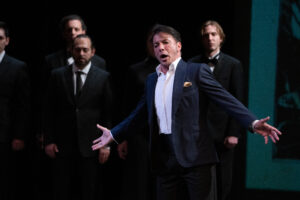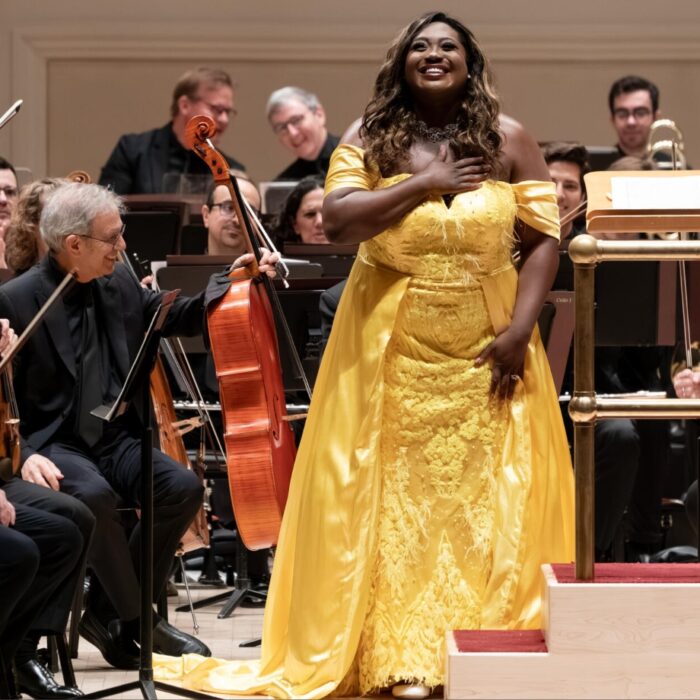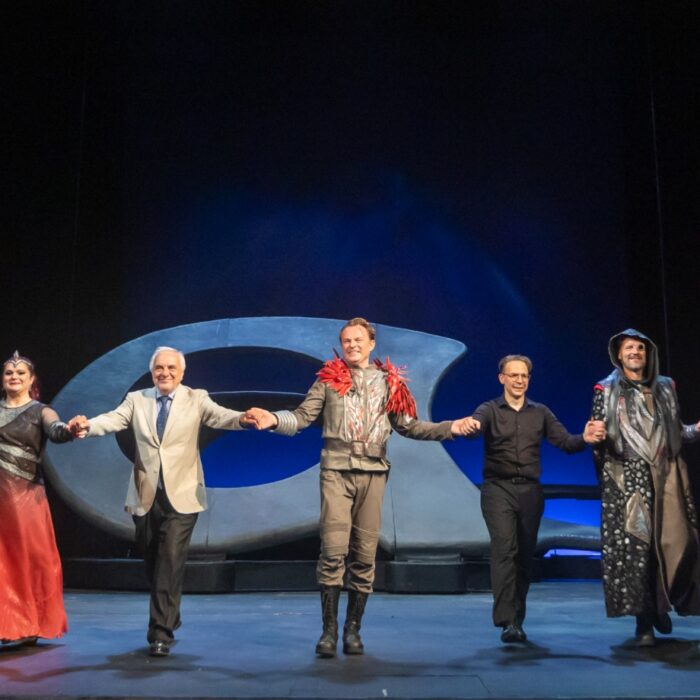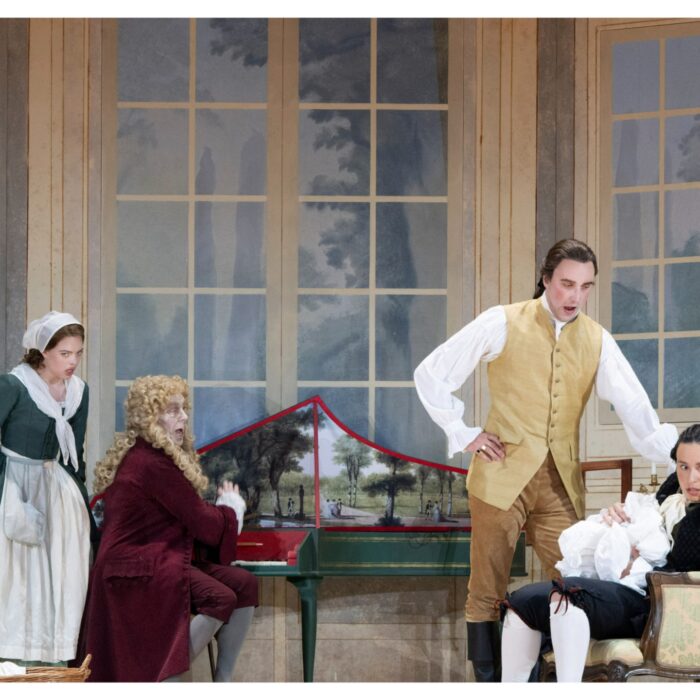
Santiago Ballerini as Poliuto. Credit: Steve Pisano
Donizetti’s opera “Poliuto” is an odd duck with an intriguing history. Although completed in 1838, it did not premiere until ten years later, on November 30, 1848, at Teatro San Carlo. The delay resulted from disapproval from royal Neapolitan censors, who gave a big thumbs down to portraying a saint as a jealous lover. Just before its debut, the censors handed down their judgment, scuttling the show.
In a red-faced rage, Donizetti took his opera to Paris, where it underwent a significant transformation and became known as “Les martyrs.” Beyond a mere name change, the opera is now closely aligned with the source material of Pierre Corneille’s play “Polyeucte” (1641-42). This play depicts the life of Saint Polyeuctus who was an early Christian martyr. Eugène Scribe reworked Salvatore Cammarano’s libretto and Donizetti introduced revisions such as adding a fourth act and expanding the overture, turning it into a grand opera. “Les martyrs” premiered in Paris on April 10, 1840.
Notably absent from the stage was the originally intended tenor, Adolphe Nourrit, for whom Donizetti had composed the title role. Instead, Nourrit’s rival, Gilbert Duprez, took on the part. This substitution proved fortuitous, as Nourrit’s vocal abilities and popularity deteriorated while Duprez’s career took off. Moreover, Duprez’s technique was well-suited to the demands of the role.
However, despite Duprez’s skill, the Parisian critics remained unimpressed with the opera, criticizing its lack of French character. As a result, “Les martyrs” failed to garner success.
The opera eventually returned to Italy, this time under the title “I martiri” with a retranslation by Bassi. It kept its grand opera revisions, but the original three-act version, “Poliuto,” remained the preferred rendition.
Finally, “Poliuto”
Donizetti was dead when “Poliuto” received its long-awaited premiere in Naples in 1848, with Carlo Baucardé in the title role. As for Nourrit, the ascension of Duprez coincided with Nouritt’s literal declension when in proper operatic form, he threw himself from a roof, ending his life.
Despite its tumultuous history, “Poliuto” found some favor among Italian audiences, leading to a revival in Bergamo in 1850. The opera made its New York debut in 1859, and a century later, in 1960, it was mounted by La Scala, featuring Maria Callas and Franco Corelli in the roles of Paolina and Poliuto. More recently, in 2015, Glyndebourne produced the opera with tenor Michael Fabiano as Poliuto, Ana Maria Martinez as Paolina, and Enrique Mazzola conducting.
As for New York stagings, “Poliuto” had not been mounted since the late 19th century though there has been a few concert performances. On July 19, 2023, Teatro Nuovo re-introduced Donizetti’s obscure work to the Big Apple in a semi-staged format. Leave it to this brilliant company whose core principle is to reproduce faithfully lesser-known works and showcase what musicologists characterize as the “bridge opera” between the Bel Canto and Verdian eras.
“Poliuto” is undoubtedly a meaningful and beautiful work, yet it’s dull.
Let’s be clear: Teatro Nuovo and its cast of incredible vocalists did not make it so. The concision of the story is its Achille’s Heel. There’s no room for character development and thus an affinity for them. When Poliuto and Paolina face a horrible death, you don’t care. There’s no emotional gut punch. Opera strikes the heart as much as the mind. “Poliuto” offers plenty for the mind to chew on but little to rend the heart.
Concise to a Fault
In an art form where convoluted storylines are the norm, “Poliuto” keeps things simple.
Paolina, the former lover of the Roman Proconsul in Melitene, Armenia, believes he has died in battle. She marries the Roman magistrate and nobleman, Poliuto. Lo-and-behold! Severo returns to Melitene not dead but triumphant. He’s none too happy about Paolina’s marriage and becomes even more so when he learns Poliuto has converted to Christianity. For this reason alone, Paolina could leave Poliuto and return to Severo. Yet, she’s incredibly moved by Christians praying for their enemies and stays with Poliuto.
When Poliuto discovers Severo in Paolina’s father’s house (set up by the opera’s villain, Callistene), he becomes jealous and doubts Paolina’s love. From there, he is led to the Temple of Jupiter, which he angrily defaces. Thrown in prison and sentenced to death, Poliuto is unmoved by Paolina’s pleas for him to renounce Christianity and save his life. His abiding faith in Christ inspires Paolina to convert. Now, Severo begs both to renounce. They don’t and are led into the arena to become dinner for the lions. End of opera.
There’s no “uh, oh!” moment when Severo learns Paolina has married. Her doing so was well within her rights. It’s not as though she cheated knowingly.
Callistene is a saint (no pun) compared to Scarpia or Lady Macbeth, so there’s little to be repulsed by on the spectrum of opera antagonists.
Severo is the victim of poor war reporting. You can feel bad about that, but it doesn’t make you sympathize with his plight.
Paolina constantly defends her virtue, which is unnecessary for the above reason. She did nothing wrong.
And Poliuto is far too pious to be taken seriously.
Finally, the love between Poliuto and Paolina could be more varied and passionate. Rodolfo and Mimì, Tosca and Cavaradossi, or Tristan and Isolde, they are not. Hence the emotional ho-hum finale.
An Outstanding Historically Accurate Production
What’s left is the music, which, while very rich, is more Verdian than Bel Canto. Unsurprisingly, the opera is considered a bridge between the two eras.
There’s plenty of fioritura, and the score asks a lot of the singers, technically speaking. What’s missing is the excitement of speedy cabalettas and high-flying tessitura that get the blood pumping.
It’s worth repeating that the Teatro Nuovo vocalists and orchestra bear no fault. Theirs was a brilliant performance that showed off aspects of singing, often lost by even the most seasoned vocalists.
The lack of fireworks was replaced by some of the most beautiful examples of head and chest voice, incredible command of dynamics, and the time-travel back to the early 19th century with an orchestra—at audience level— comprising period instruments led by a primo violino e direttore dell’opera, not a “conductor” as we know them today. Here is where we’ll start.
Jakob Lehmann is an astute musician who leads with power. As Primo Violino e Direttore, he had dual responsibilities; when not using his bow as a baton, he commanded the orchestra while playing the violin. We see this type of management in string ensembles, with the first violinist leading the others by using head and body movements to communicate. Imagine a concerto performance with no conductor, just the soloist leading the way with their back to the audience. That should give you an excellent picture.
Lehmann was a thrill to watch. He’d punch the air hard when the score called for orchestral hits. Pow! He used small cues with the vocalists—wiggles of the fingers, slight hand gestures, and nods. Frenzy seamlessly segued into gracefulness.
The orchestra sat at audience level, not hidden within a pit. This provided the instrumentalists with a full view of the conductor and what was happening onstage, allowing them to “read” the vocalists and their colleagues while never losing an excellent sightline to Lehmann.
According to the program notes, no orchestral detail was spared. There were horns without valves and other odd brass. Strings were strung with gut, not metal. The basses had just three strings, and the woodwinds, well, were wooden. The low-string sections were placed differently, positioned on either side, so the musical foundation was audibly available to all members.
The woodwind-heavy opening bars of the overture sounded weird—as in off— because today’s orchestral instruments don’t produce the same tone as their forbearers; it takes a few minutes to acclimate the ears. But once the brain catches on, what a glorious sound! It’s one of centuries past; it’s how yesterday’s audiences experienced music. Tutti passages filled the theater and the soul while muted moments pulled you forward in your seat.
Lehmann and his band were as near flawless as could be. To get there using period instruments, a primo violino e direttore needs a deep knowledge of pre-modern sound production and repertoire. Lehmann doesn’t dabble in Bel Canto; it’s his performer, conductor, and researcher specialty. His contract with Teatro Nuovo began in 2019 and was extended through 2025. “Poliuto” showed why.
Vocal Performances
Let’s talk about vocal performances. Except for a few instances where projection just didn’t cut, the singers also had a phenomenal outing.
Tenor Santiago Ballerini sang the title role. His light yet sonorous voice lent itself well to Bel Canto singing, and he is one of the era’s top interpreters. He had excellent agility as he moved through the fioritura and had no issues sending his voice over the orchestra. Most impressive was his use of dynamics and head voice. He went from full-throated fortes to the gentlest pianissimos with utmost surety. Lehmann gave plenty of room for each singer to take their time, and Ballerini certainly did so without seeming overdramatic. Lehmann’s colla voce approach toned down the band or extended pauses. This allowed Ballerini to show off what was a mystifying head voice of such gentle persuasion of the dramatic significance of the passage that left little doubt about what he was expressing. Likewise, the more intense sections where the tone and shading of the lines were an emotional barometer.
Since the performance was semi-staged, it gave the singers room to move about and act their parts.
Ballerini’s counterpart, soprano Chelsea Lehnea, brought depth, not just to the role of Paolina, but literal depth with her chest voice. She moved quickly and seamlessly through the passaggi, dropping into and out of her registers with equal strength. Her use of chest voice gave Paolina a powerful punch, providing unmistakable dramaticism and a clear sense of the character’s various emotional states, ranging from anger to despair.
Between Ballerini’s head voice and Lehnea’s chest voice, the audience received a lesson in beautifully nuanced performances. As mentioned earlier, while the typical Bel Canto barn-burning passages were markedly absent from the opera, the confluence of the two ends of the vocal spectrum added a significant deal of anticipation. They are dangerous places for singers to hang out. Rather than rushing through to survive and move on to more ‘safe’ singing, Lehnea kept the audience’s attention because of the inherent danger of a passage going sideways and because the vocalist either doesn’t have the strength or confidence to stick their neck out. Lehnea had both in spades.
Her interactions with Ballerini’s Poliuto were believable. Still, since the libretto was sliced so thin, the lack of character development hampers the role, and there’s only so much a singer can do vocally and physically to build deeper connections between character and audience. However, Paolina struggled between loving her mistakenly dead lover, Severo, and her very much alive husband, Poliuto. At the opera’s finale—and again, faulting the story, not Lehnea—the jump from a devotee of Jove to her becoming a Christian is far too abrupt to be in any way believable or impactful. It appeared spontaneous and rash rather than coming from a place of deep love for Poliuto. This left a feeling of, “Okay, I’ll guess I’ll die, too.” And off she goes to the lions.
In the role of Severo, baritone Ricardo José Rivera delivered gravitas befitting a Roman Pro Consul for his company debut. Rivera isn’t an in-your-face booming baritone, yet he possesses a commanding stage presence and is one of the strongest members of the cast acting-wise. His shock upon learning of his ‘death’ and that Paolina has moved on to a new life with Poliuto registered emotionally. Interestingly, not his machinations ensnare Poliuto, but that of Callistene, the High Priest of Jupiter. How might Severo have dealt with the quandary alone? Kill Poliuto immediately, which he could easily do since Christianity was illegal, and move on. Problem solved. He doesn’t need the trickery Callistene conjures to draw out Poliuto’s jealousy. That he follows Callistene’s lead rather than exercising his power is intriguing.
Rivera brought this aspect to the forefront and portrayed a torn person. Paolina is torn, and that appears to stay his hand as he contemplates how to remove Poliuto from the picture while not alienating himself from Paolina’s love. Though not warm, the baritone gives Severo enough heart to make him hesitant to execute his rival, so much so he offers Poliuto (and Paolina) an escape from death: renounce Christianity, and the lions go hungry.
The bad guy in all this is Callistene, the High Priest, sung by bass Hans Tashjian. The High Priest doesn’t have much stage time for an antagonist. His vileness isn’t all that vile, leaving the audience with little disgust. There’s not much to work with; his ‘evil’ plans consist entirely of trying to get a rise out of Poliuto. First, make him jealous by bringing Severo to Paolina’s father’s house, then enrage him at the Temple until he does something rash, like vandalizing it in front of everyone, both forms of passive villainy.
Because of the passivity, there’s little room for acting, making singing the sole vehicle for conveying wickedness. Tashjian struggled to be heard above the chorus and orchestra. In a previous Teatro Nuovo role as Figaro in “Barber,” he was excellent at acting and singing. Tashjian has also covered and sung at the Met. Why he couldn’t be heard is a head-scratcher. Lehmann kept the orchestra and choir dynamics in check, but the bass was absent from the wave of sound.
He sounded excellent when soloing or in duet, so the essential parts reached the audience’s ears. The trouble arose when the stage was full.
The choir was tight, especially when singing offstage, which is always tricky. Their sound was well-balanced, and the music was executed without a hitch.
A limited number of projections were used as sets, and though not exciting, they couldn’t have defined a sense of place for each act better. Supertitles sat at the top of the projections and were done in a complementary style that blended nicely with the image and placed to be readable without taking your eyes off the action on stage.
Teatro Nuovo’s dedication to historically accurate semi-staged shows is no gimmick; it’s exciting, informative, and the closest thing to musical time-traveling you can get.



